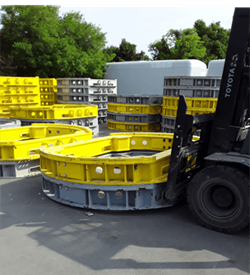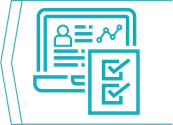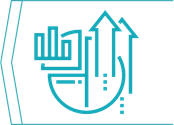Bayside 5S+ Cost Savings Project
The following case study exhibits the project as it was designed and executed through the DMAIC (define, measure, analyze, improve, control) principles of Six Sigma.
Table of Contents
Backstory
Landrum has a manufacturing client with which our Workforce

Management onsite leaders are responsible for material handling and assembly functions. Part of our agreement is defining annual cost savings projects and managing them from start to finish.
One of those projects we completed was called the “Bayside 5S+ Project.” The Bayside location is a three-acre concrete paved area directly across from the plant entrance. Its primary function was as a semi-truck check-in and hold area. The space also doubled as a scrap collection area.
Issues/Challenges Identified
One problem we identified is that our client was paying storage costs for shipping fixtures that were reused after returning from the field. Offsite storage for these, and other material, totaled over $1 million per year.
 Shipping fixtures that were causing excess storage costs
Shipping fixtures that were causing excess storage costs
Goal
Our primary goal for this event was to relocate as many shipping fixtures as possible from the offsite warehouse to Bayside through a structured Kaizen event with a multi-company subject matter expert (SME) team. This team consisted of Landrum, the client, and the third-party transportation company.
The stretch goal was to increase the flow of incoming trucks to eliminate confusion, as well as increase the capacity of “waiting” spots or parking spots.
Key Performance Indicators Tracked (KPIs) Tracked
The primary focus metric was defining actual hard savings realized

over a 12-month period, per the client agreement. All projects from January through December were in scope.
We also measured truck data such as largest size and turning radius, maximum quantity per day, and throughput allowed on plant per hour. It was also important to identify all other processes currently taking place in Bayside and its current footprint.
Trend Data
We identified the following data sets as in scope:

- 218 shipping fixtures of 4 different sizes, which are billed differently.
- After a Gemba walk, we recognized over 100 fixtures that were damaged past acceptable limits.
- Transportation of fixtures to the plant from an offsite warehouse each week was adding unneeded cost.
- A minimum of 36 parking spots were needed to accommodate the maximum truck quantity.
- Other processes in the area included: fixture repair area, fixture quality check and flip, lifting eye consolidation, Nacelle storage, and truck check-in.
Preparation
Over several one-hour structured meetings, the team collectively performed a 3P Layout Event (production, preparation, process) and incorporated 5S methodologies into the design. The result was a detailed roadmap of actions to get to the desired state.
 Overview of the Bayside check-in and hold area.
Overview of the Bayside check-in and hold area.Execution Efforts
 The new layout was executed over a weekend using a team of experts, leaders, and drivers. Fixture locations were designed with min/max triggers. Truck parking spots totaled 41 with a clear incoming and outgoing flow of traffic.
The new layout was executed over a weekend using a team of experts, leaders, and drivers. Fixture locations were designed with min/max triggers. Truck parking spots totaled 41 with a clear incoming and outgoing flow of traffic.
Storage savings for 218 fixtures totaled $161,538 per year. Recycling payback calculated by actual steel recycling contract plus the savings of no longer storing scrap in an offsite warehouse totaled $149,774.97 for.
Total savings for this project in 2020 was $311,312.97.
Follow-Up Efforts

In order to sustain the layout and accurate material levels, we:
- Created standardized work for each process.
- Implemented a weekly 5S audit, with members from all three companies involved.
- Set up a daily layered process audit (LPA), ensuring standard work was being followed.
- Set up a 30/60/90 day and annual layout review with the team for continuous improvement.
Conclusion
In summary, Landrum identified and managed from start to end, a multi-company cost savings project with a total hard savings of over $300K for. This benefit came at no additional charge to the client.
We understand that the better our clients perform, the better it is for our relationship. Our lean philosophy is not only about identifying and eliminating waste, but also understanding creative ways to maximize value to our customer.
Key Takeaways
 Landrum facilitated a multi-company cost savings project using lean methodology.
Landrum facilitated a multi-company cost savings project using lean methodology.- Total hard savings for this project over was $311,312.97.
- Implemented standardized work and layered process audits to sustain efforts.
- No additional cost to the client.